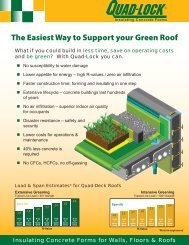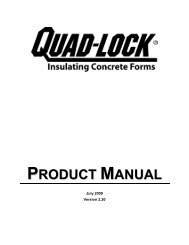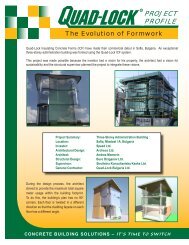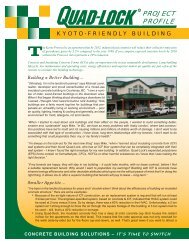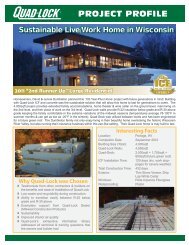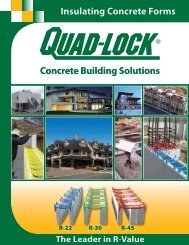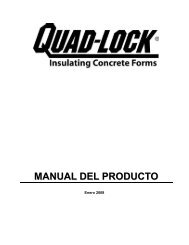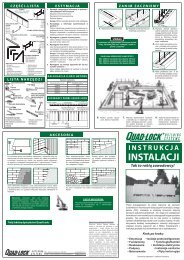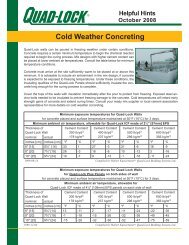Behaviour of EPS in case of Fire - Quad-Lock Building Systems
Behaviour of EPS in case of Fire - Quad-Lock Building Systems
Behaviour of EPS in case of Fire - Quad-Lock Building Systems
Create successful ePaper yourself
Turn your PDF publications into a flip-book with our unique Google optimized e-Paper software.
<strong>Behaviour</strong> <strong>of</strong> <strong>EPS</strong> <strong>in</strong> <strong>case</strong> <strong>of</strong> fire<br />
European Manufacturers <strong>of</strong> <strong>EPS</strong>
Introduction<br />
The purpose <strong>of</strong> this document is to clearly quantify the fire performance <strong>of</strong> expanded polystyrene<br />
(<strong>EPS</strong>) when used as an <strong>in</strong>sulation material <strong>in</strong> build<strong>in</strong>gs. This document will consider all aspects <strong>of</strong><br />
the fire performance <strong>of</strong> <strong>EPS</strong> <strong>in</strong> terms <strong>of</strong> heat release, flame spread, smoke production and toxicity<br />
and its contribution to the propagation <strong>of</strong> fire. Detailed <strong>in</strong>formation is provided on the<br />
characteristics <strong>of</strong> <strong>EPS</strong> foam as a basis for evaluat<strong>in</strong>g its behaviour when subjected to ignition<br />
sources. The performance <strong>of</strong> fire retardant additives is also evaluated. This <strong>in</strong>formation can be used<br />
for hazard assessment tak<strong>in</strong>g <strong>in</strong>to account the complexity <strong>of</strong> a real fire and the difficulty <strong>of</strong><br />
modell<strong>in</strong>g real fire situations from scaled tests.<br />
General<br />
Expanded polystyrene is derived ma<strong>in</strong>ly from<br />
styrene monomer and expanded to form a<br />
cellular structure substantially <strong>of</strong> closed cells.<br />
When consider<strong>in</strong>g the fire behaviour <strong>of</strong> any<br />
build<strong>in</strong>g material it is important to realise<br />
that the assessment must be based on its<br />
performance <strong>in</strong> end-use conditions. This<br />
performance will depend on not only the<br />
chemical nature <strong>of</strong> the material but to a<br />
greater extent on its physical state.<br />
Thus the important factors which must be<br />
considered <strong>in</strong> determ<strong>in</strong><strong>in</strong>g the potential fire<br />
hazard <strong>of</strong> <strong>EPS</strong> are:<br />
• the foam density and shape <strong>of</strong> the product<br />
• its configuration relative to an ignition<br />
source<br />
• the use <strong>of</strong> any bond<strong>in</strong>g to a substrate or<br />
fac<strong>in</strong>g<br />
• the location <strong>of</strong> the product (which will<br />
<strong>in</strong>fluence the heat transport)<br />
• the availability <strong>of</strong> oxygen (ventilation)<br />
Stages <strong>of</strong> a<br />
Build<strong>in</strong>g fire<br />
(How a Build<strong>in</strong>g fire develops)<br />
When a build<strong>in</strong>g is <strong>in</strong> everyday use at normal<br />
temperature conditions, there is a natural balance<br />
between flammable materials and oxygen <strong>in</strong> the<br />
environment. However at the <strong>in</strong>itial stage <strong>of</strong> a fire,<br />
ignition energy comes <strong>in</strong>to contact with the flammable<br />
material. Above a temperature <strong>of</strong> approximately 200° C,<br />
the material will give <strong>of</strong>f flammable gases, which will<br />
combust either due to the orig<strong>in</strong>al ignition energy or<br />
spontaneously. In the <strong>case</strong> <strong>of</strong> gases, combustion can lead<br />
directly to flames whereas with solid materials, such as<br />
furniture, they first become glow<strong>in</strong>g ignition sources.<br />
In the first stage <strong>of</strong> a fire, there is a gradual build up <strong>of</strong><br />
heat energy <strong>in</strong> the form <strong>of</strong> combustible gases. Up to this<br />
po<strong>in</strong>t the temperature is still relatively low and the fire<br />
is still localised with<strong>in</strong> the build<strong>in</strong>g. Then all <strong>of</strong> a<br />
sudden a development takes place, called 'flash-over',<br />
<strong>in</strong> which the temperature <strong>in</strong>creases significantly and the<br />
fire suddenly spreads all over the compartment. After<br />
this flash-over the chances <strong>of</strong> rescu<strong>in</strong>g people and<br />
equipment are greatly reduced. The fire then spreads<br />
throughout the whole <strong>of</strong> the build<strong>in</strong>g and will f<strong>in</strong>ally<br />
go out without human <strong>in</strong>tervention due to the lack <strong>of</strong><br />
flammable materials.<br />
temperature<br />
’flash-over’<br />
exit build<strong>in</strong>g and beg<strong>in</strong><br />
fire-fight<strong>in</strong>g procedure<br />
time<br />
fire at its peak<br />
cool<strong>in</strong>g down/<br />
ext<strong>in</strong>guish<strong>in</strong>g
The behaviour<br />
<strong>of</strong> <strong>EPS</strong> <strong>in</strong> a fire<br />
General<br />
Like practically all organic build<strong>in</strong>g materials<br />
polystyrene foam is combustible. However <strong>in</strong> practice<br />
its burn<strong>in</strong>g behaviour depends on the conditions under<br />
which it is used, as well as the <strong>in</strong>herent properties <strong>of</strong><br />
the material. These <strong>in</strong>herent properties differ depend<strong>in</strong>g<br />
on whether the cellular material is made from <strong>EPS</strong> with<br />
or without a fire retardant additive. The bond<strong>in</strong>g <strong>of</strong><br />
other materials to cellular polystyrene also considerably<br />
affects its burn<strong>in</strong>g behaviour. For example, foil-faced<br />
products have an improved surface spread <strong>of</strong> flame<br />
performance. When <strong>in</strong>stalled correctly, expanded<br />
polystyrene products do not present an undue fire<br />
hazard. It is strongly recommended that expanded<br />
polystyrene should always be protected by a fac<strong>in</strong>g<br />
material, or by complete encapsulation.<br />
When burn<strong>in</strong>g, expanded polystyrene behaves like other<br />
hydrocarbons such as wood, paper etc. The products <strong>of</strong><br />
combustion are basically carbon monoxide and styrene:<br />
dur<strong>in</strong>g a fire, the styrene may be further decomposed,<br />
giv<strong>in</strong>g <strong>of</strong>f oxides <strong>of</strong> carbon, water and a certa<strong>in</strong> amount<br />
<strong>of</strong> soot (smoke).<br />
<strong>EPS</strong> is produced <strong>in</strong> two types: the standard quality and<br />
the fire-retardant modified quality, designated by the<br />
code 'SE'. Flame retarded or SE grades, which make<br />
the expanded material much more difficult to ignite,<br />
considerably reduce rates <strong>of</strong> spread <strong>of</strong> flame.<br />
Some countries, such as those <strong>in</strong> Scand<strong>in</strong>avia, only<br />
use the standard grade, whereas others, Germany for<br />
example, only use the SE grade. However, <strong>in</strong> many<br />
European countries, both grades are used.<br />
If <strong>EPS</strong> is exposed to temperatures above 100° C,<br />
it beg<strong>in</strong>s to s<strong>of</strong>ten, to contract and f<strong>in</strong>ally to melt.<br />
At higher temperatures, gaseous combustible products<br />
are formed by decomposition <strong>of</strong> the melt. Whether or<br />
not these can be ignited by a flame or spark depends<br />
largely on the temperature, duration <strong>of</strong> exposure to<br />
heat and air flow around the material (the oxygen<br />
availability) 1 . Molten <strong>EPS</strong> will normally not be ignited<br />
by weld<strong>in</strong>g sparks or glow<strong>in</strong>g cigarettes; however, small<br />
flames will ignite <strong>EPS</strong> readily unless it conta<strong>in</strong>s flame<br />
retardant additives (SE Grade ). The transfer ignition<br />
temperature is 360° C. In the <strong>case</strong> <strong>of</strong> <strong>EPS</strong>-SE, this is<br />
370° C. These values <strong>in</strong>dicate that if melted <strong>EPS</strong><br />
dis<strong>in</strong>tegrates then combustible gases are only formed<br />
above 350° C. In the absence <strong>of</strong> an energy source<br />
(pilot flame) the self-ignition temperature <strong>of</strong> melted<br />
<strong>EPS</strong> <strong>in</strong> its standard grade is 450° C. After ignition <strong>of</strong><br />
standard grade <strong>EPS</strong>, burn<strong>in</strong>g will readily spread over<br />
the exposed surface <strong>of</strong> the <strong>EPS</strong>, and it will cont<strong>in</strong>ue to<br />
burn until all <strong>EPS</strong> is consumed. While the low density<br />
<strong>of</strong> the foam contributes to the ease <strong>of</strong> burn<strong>in</strong>g through a<br />
higher ratio <strong>of</strong> air (98%) to polystyrene (2%), the mass<br />
<strong>of</strong> the material present is low and hence the amount <strong>of</strong><br />
heat released is also low.<br />
Contribution to the<br />
propagation <strong>of</strong> fire<br />
Build<strong>in</strong>g Regulations all over Europe stipulate<br />
requirements <strong>in</strong> respect <strong>of</strong> a complete structure and<br />
work on the basis <strong>of</strong> specify<strong>in</strong>g the contribution to<br />
the propagation <strong>of</strong> fire, from the response to fire-load<br />
density on the surface <strong>of</strong> a structural component.<br />
This is called the 'Reaction-to-<strong>Fire</strong>'classification<br />
system.<br />
Classification systems and fire tests differ all over<br />
Europe; however, a system <strong>of</strong> "Euroclasses" is<br />
developed these days and is expected to be available<br />
<strong>in</strong> 2000.
<strong>Fire</strong>-retardants<br />
The presence <strong>of</strong> fire retardant additives <strong>in</strong> SE grades<br />
leads to significant improvements <strong>in</strong> the fire behaviour<br />
<strong>of</strong> <strong>EPS</strong>. While the complexity <strong>of</strong> a real fire situation<br />
makes it very difficult to predict overall fire<br />
performance from laboratory tests, there are several<br />
small-scale tests which clearly show that it is much<br />
more difficult to ignite <strong>EPS</strong> made from grades with<br />
a fire retardant additive than standard grades.<br />
In the presence <strong>of</strong> large ignition sources or significant<br />
heat fluxes, e.g. greater than 50 kW/m 2 , from fires<br />
<strong>in</strong>volv<strong>in</strong>g other material, <strong>EPS</strong> SE grades will<br />
eventually burn, reflect<strong>in</strong>g the organic nature <strong>of</strong><br />
polystyrene. In such <strong>in</strong>stances the build<strong>in</strong>g is usually<br />
beyond the po<strong>in</strong>t <strong>of</strong> rescue 3 .<br />
<strong>EPS</strong>-SE grade conta<strong>in</strong>s a small quantity <strong>of</strong> a fireretardant<br />
agent (max. 0.5 %). This is the fire retardant<br />
hexabromocyclododecan (HBCD). This has a beneficial<br />
effect when <strong>EPS</strong> is exposed to a fire source. The foam<br />
shr<strong>in</strong>ks rapidly away from the heat source, thus<br />
reduc<strong>in</strong>g the likelihood <strong>of</strong> ignition. The decomposition<br />
products <strong>of</strong> the additive(s) cause flame quench<strong>in</strong>g, so<br />
that when the ignition source is removed, the <strong>EPS</strong><br />
will not cont<strong>in</strong>ue to burn.<br />
HBCD is a so-called cyclo-aliphatic organobrom<strong>in</strong>e<br />
compound and is not comparable with the aromatic fire<br />
retardants (PBBs and PBBOs), the use <strong>of</strong> which has been<br />
banned for some time. Indeed, HBCD does not form any<br />
toxic diox<strong>in</strong>s and furanes dur<strong>in</strong>g combustion. This was<br />
concluded by the German M<strong>in</strong>istry for the Environment<br />
<strong>in</strong> 1990, for the combustion <strong>of</strong> polystyrene with an<br />
HBCD content that was at least five times greater than<br />
normal (3 percent by weight). They found that HBCD is<br />
not a source for the build-up <strong>of</strong> polybromodibenz<strong>of</strong>uranes<br />
and –diox<strong>in</strong>s when us<strong>in</strong>g different types <strong>of</strong> combustion<br />
oven over a temperature range <strong>of</strong> 400 to 800° C 2 . The<br />
same result had previously been concluded by the Dutch<br />
M<strong>in</strong>istry for the Environment 3 <strong>in</strong> 1989 for pyrolysis <strong>of</strong><br />
polystyrene with an HBCD content <strong>of</strong> 10 percent (<strong>in</strong> fire<br />
retardant modified <strong>EPS</strong> there is only 0.5 %). A study <strong>in</strong><br />
1992 by the well known German Freseniusl Institute 4<br />
itself showed that <strong>in</strong> the HBCD itself there were no<br />
brom<strong>in</strong>ated diox<strong>in</strong>s or furanes to be demonstrated.<br />
Recent research at the Karlsruher test <strong>in</strong>c<strong>in</strong>erator<br />
'Tamara' has demonstrated that the combustion <strong>of</strong><br />
polystyrenes <strong>in</strong> a modern combustion oven is an<br />
environmentally friendly method <strong>of</strong> recycl<strong>in</strong>g <strong>in</strong> terms<br />
<strong>of</strong> emissions.<br />
Also as HBCD is <strong>in</strong>soluble <strong>in</strong> water there is therefore<br />
no risk due to migration to water 5 .<br />
Heat Release<br />
The rate <strong>of</strong> heat release has lately been considered an<br />
important parameter for assess<strong>in</strong>g the fire behaviour<br />
<strong>of</strong> materials . The test method developed as ISO 5660<br />
us<strong>in</strong>g a cone calorimeter allows specimens to be burnt<br />
under a range <strong>of</strong> impressed heat fluxes. Tests <strong>in</strong> an<br />
<strong>in</strong>dustry-laboratory showed that <strong>EPS</strong> board shrank<br />
rapidly away from the heat source and collapsed <strong>in</strong>to<br />
a film <strong>of</strong> molten polystyrene. No flam<strong>in</strong>g ignition was<br />
observed at a heat flux <strong>of</strong> up to 20 kW/m 2 . For higher<br />
heat fluxes, the overall rate <strong>of</strong> heat release (RHR) and<br />
peak RHR were lower for SE grades with a fire<br />
retardant additive than for standard grades.<br />
The calorific value <strong>of</strong> expanded polystyrene materials<br />
(40 MJ/kg) is about twice that <strong>of</strong> timber (18.6 MJ/kg)<br />
but tak<strong>in</strong>g <strong>in</strong>to account the comparative densities<br />
<strong>of</strong> the two products, the calorific volume by volume<br />
<strong>of</strong> expanded polystyrene materials is 540 MJ /m 3<br />
to 1250 MJ /m 3 compared with 7150 MJ /m 3 to<br />
10 400 MJ /m 3 for cellulosic products, such as fibre,<br />
<strong>in</strong>sulat<strong>in</strong>g board, or timber.<br />
The overall heat content <strong>of</strong> materials <strong>in</strong>fluences fire<br />
severity <strong>in</strong> terms <strong>of</strong> fire growth and the rate <strong>of</strong> release<br />
<strong>of</strong> heat content is <strong>of</strong> major importance. This is very<br />
dependent on combustion conditions. Heat release from<br />
expanded polystyrene materials is about three times as<br />
rapid as from s<strong>of</strong>twood timber, but is <strong>of</strong> much shorter<br />
duration (6.7.8) .<br />
The extent and rate <strong>of</strong> heat release is limited primarily<br />
by ventilation. For example, a foam <strong>of</strong> density<br />
16 kg / m 3 requires over 150 times the volume <strong>of</strong> air to<br />
achieve complete combustion. Complete combustion <strong>of</strong><br />
expanded polystyrene is unlikely to occur, so its full<br />
potential heat is rarely released<br />
A 200mm-thick layer <strong>of</strong> <strong>EPS</strong> with a density <strong>of</strong><br />
20kg/m3 represents the same amount <strong>of</strong> energy<br />
as a 17mm-thick layer <strong>of</strong> p<strong>in</strong>e wood. But who<br />
hesitates to use 17mm-thick p<strong>in</strong>e as unprotected<br />
surface on a ceil<strong>in</strong>g or a wall?
Smoke<br />
Smoke is an important factor <strong>in</strong> fire. A high density<br />
<strong>of</strong> smoke will <strong>in</strong>hibit the search for an emergency exit<br />
thereby <strong>in</strong>creas<strong>in</strong>g the risks to occupants. Smoke fumes<br />
can also be toxic or have a low oxygen content, while<br />
(hot) soot particles are able to block and adversely affect<br />
the breath<strong>in</strong>g organs.<br />
When assess<strong>in</strong>g potential smoke emission from expanded<br />
polystyrene materials <strong>in</strong> a build<strong>in</strong>g under fire conditions,<br />
essential factors to be considered <strong>in</strong>clude the<br />
possible extent <strong>of</strong> flame spread over any surface designed<br />
to protect expanded polystyrene materials, the ventilation<br />
conditions and the rate <strong>of</strong> decomposition <strong>of</strong> the<br />
polystyrene. Effective surface protection will restrict<br />
flam<strong>in</strong>g to areas where the coat<strong>in</strong>g has failed and where<br />
molten polystyrene or gaseous decomposition products<br />
have escaped through jo<strong>in</strong>ts and small fissures.<br />
Flame Spread<br />
Flame spread is a process <strong>of</strong> progressive ignition along<br />
a cont<strong>in</strong>uous surface. The extent and rate <strong>of</strong> flame spread<br />
depend largely on the ignitability <strong>of</strong>, and rate <strong>of</strong> heat release<br />
from, a combustible material. In l<strong>in</strong><strong>in</strong>gs where expanded<br />
polystyrene material is attached to a rigid substrate and is<br />
provided with a protective exterior fac<strong>in</strong>g, the risk <strong>of</strong> flame<br />
spread is also affected by the physical / thermal properties<br />
<strong>of</strong> the surface on to which the expanded polystyrene material<br />
may have melted.<br />
The proximity <strong>of</strong> the substrate and the degree <strong>of</strong> <strong>in</strong>tegrity <strong>of</strong><br />
the protective fac<strong>in</strong>g (where it still rema<strong>in</strong>s) as well as the<br />
design <strong>of</strong> fix<strong>in</strong>gs and jo<strong>in</strong>ts govern the distribution <strong>of</strong> any<br />
molten polystyrene and the supply <strong>of</strong> air and heat to the<br />
combustion zone. If adhesive has been used overall to<br />
attach expanded polystyrene material to a surface fac<strong>in</strong>g,<br />
melt<strong>in</strong>g will result <strong>in</strong> attachment to this surface but where<br />
thick sheets have been <strong>in</strong>stalled, particularly horizontally,<br />
failure <strong>of</strong> the surface fac<strong>in</strong>g can result <strong>in</strong> the formation and<br />
fall<strong>in</strong>g <strong>of</strong> molten drops, <strong>of</strong>ten flam<strong>in</strong>g.<br />
Where localised failure <strong>of</strong> a protective fac<strong>in</strong>g has occurred,<br />
air supply to, and the orientation <strong>of</strong>, the surface <strong>of</strong> the<br />
exposed expanded polystyrene material are important <strong>in</strong><br />
determ<strong>in</strong><strong>in</strong>g the subsequent risk <strong>of</strong> flame spread, (e.g. <strong>in</strong><br />
a cavity wall <strong>in</strong>sulated with expanded polystyrene material),<br />
extensive spread is unlikely because <strong>of</strong> lack <strong>of</strong> circulation <strong>of</strong><br />
combustion air (9, 10) .<br />
Prediction <strong>of</strong> the precise smoke-produc<strong>in</strong>g potential<br />
<strong>of</strong> polystyrene is difficult because <strong>of</strong> the wide range <strong>of</strong><br />
combustion conditions likely to be met with<strong>in</strong> the actual<br />
fire. Generalised conclusions from small scale tests have<br />
been substantiated by evidence from fire <strong>in</strong>cidents. In a<br />
flam<strong>in</strong>g fire expanded polystyrene materials produce<br />
more smoke from a given mass <strong>of</strong> material than most<br />
other materials. It should however be noted that<br />
expanded polystyrene materials conta<strong>in</strong> only 2 % by<br />
vol. <strong>of</strong> solids.<br />
In actual fires where much smoke is produced, it is<br />
<strong>of</strong>ten anticipated that this orig<strong>in</strong>ates from burn<strong>in</strong>g <strong>EPS</strong><br />
ro<strong>of</strong> <strong>in</strong>sulation. In extreme <strong>case</strong>s this claim is made<br />
even for fires <strong>in</strong> build<strong>in</strong>gs without any <strong>EPS</strong> <strong>in</strong>sulation.<br />
In fact, most <strong>of</strong> the smoke orig<strong>in</strong>ates from materials<br />
such as burn<strong>in</strong>g wood, asphalt felt and furniture,<br />
especially after the first short phase <strong>of</strong> fire.<br />
From recent research it is possible to quantify the<br />
contribution made, separately by the <strong>in</strong>sulant, to fire growth<br />
<strong>in</strong> free ventilated enclosures where expanded polystyrene<br />
material <strong>in</strong>sulant is used <strong>in</strong> wall panels or wall and / or<br />
ceil<strong>in</strong>g l<strong>in</strong><strong>in</strong>gs. The extent <strong>of</strong> <strong>in</strong>volvement <strong>of</strong> the <strong>in</strong>sulant,<br />
amongst other factors, is dependent on the failure pattern<br />
<strong>of</strong> the protective fac<strong>in</strong>gs. With good design and careful<br />
selection <strong>of</strong> protective fac<strong>in</strong>gs, the rate at which the <strong>in</strong>sulant<br />
subsequently contributes heat, smoke, etc. to fire development<br />
<strong>in</strong>side an enclosure can be effectively reduced; the<br />
time to <strong>in</strong>volvement can also be substantially delayed (11, 12) .<br />
A large scale experimental research programme conducted<br />
by the Build<strong>in</strong>g Research Establishment (BRE) <strong>in</strong> England,<br />
simulat<strong>in</strong>g the effects <strong>of</strong> a fully developed room fire over<br />
a large area <strong>of</strong> externally <strong>in</strong>sulated masonry assemblies,<br />
has identified the design features affect<strong>in</strong>g their fire<br />
performance (13) . Where expanded polystyrene sheet<strong>in</strong>g is<br />
used, by careful selection <strong>of</strong> the protective weather<strong>in</strong>g<br />
f<strong>in</strong>ish, with suitable design and <strong>in</strong>stallation <strong>of</strong> its support<br />
and correct <strong>in</strong>stallation around reveals, together with<br />
appropriate fire barriers, it is possible to reduce effectively<br />
the contribution made by an <strong>in</strong>sulant to progressive vertical<br />
fire spread over the external f<strong>in</strong>ish or through the <strong>in</strong>sulant /<br />
cavity; the extent <strong>of</strong> fire damage can also be limited.<br />
The fire performance <strong>of</strong> homogeneous lightweight renders<br />
conta<strong>in</strong><strong>in</strong>g expanded polystyrene beads as aggregates<br />
applied externally to solid masonry walls has been shown<br />
to be satisfactory.
The smoke particles produced <strong>in</strong> a flam<strong>in</strong>g fire are large,<br />
black and irregular <strong>in</strong> shape. The density <strong>of</strong> the smoke<br />
produced <strong>in</strong>creases with <strong>in</strong>creas<strong>in</strong>g temperature and<br />
with the <strong>in</strong>tensity <strong>of</strong> the heat flux onto the material. In a<br />
smoulder<strong>in</strong>g fire, e.g. where the expanded polystyrene<br />
materials rema<strong>in</strong> effectively protected and decomposition<br />
occurs <strong>in</strong> oxygen deficient conditions, small spherical<br />
grey particles predom<strong>in</strong>ate and the specific optical<br />
density values are lower than for flam<strong>in</strong>g conditions.<br />
When exposed <strong>EPS</strong> burns, it generates a considerable<br />
amount <strong>of</strong> heavy, dense, black smoke, which is usually<br />
proportional to the mass consumed by the fire. It is<br />
sometimes argued that the toxicity <strong>of</strong> the smoke fumes<br />
will be <strong>in</strong> proportion to the density <strong>of</strong> the smoke but this<br />
appears not to be the <strong>case</strong>.<br />
For applications where <strong>EPS</strong> is used without a protective<br />
Toxicity<br />
As discussed earlier it is difficult to predict the behaviour<br />
<strong>in</strong> real fires from small-scale tests. The same considerations<br />
apply to assess<strong>in</strong>g the hazards <strong>of</strong> gaseous emissions<br />
from burn<strong>in</strong>g materials. In practice, two approaches are<br />
followed; firstly, the determ<strong>in</strong>ation <strong>of</strong> thermal decomposition<br />
products and, secondly, studies <strong>of</strong> their biological<br />
effects. It is necessary to comb<strong>in</strong>e the two approaches to<br />
obta<strong>in</strong> a realistic overall estimate <strong>of</strong> the hazards.<br />
Although burn<strong>in</strong>g <strong>EPS</strong> gives <strong>of</strong>f black smoke, the<br />
toxicity <strong>of</strong> the released smoke fumes is considerably less<br />
than those <strong>of</strong> other commonly used materials. This was<br />
already concluded <strong>in</strong> 1980 by the TNO Centre for <strong>Fire</strong><br />
Safety 14 for both <strong>EPS</strong> <strong>in</strong> its standard design and <strong>EPS</strong><br />
to SE quality. The toxicity <strong>of</strong> fumes was measured for<br />
wood, wool, silk, cotton, fire retardant treated cotton<br />
and three sorts <strong>of</strong> <strong>EPS</strong> (see table). In the <strong>case</strong> <strong>of</strong> <strong>EPS</strong> the<br />
toxicity <strong>of</strong> the smoke appeared to be considerably<br />
smaller than that <strong>of</strong> the other materials.<br />
Extensive research <strong>in</strong>to the toxicity <strong>of</strong> smoke fumes<br />
from burn<strong>in</strong>g <strong>EPS</strong> has also been conducted <strong>in</strong><br />
accordance with the DIN 53436 method which is a<br />
small scale combustion toxicity test, which gives results<br />
<strong>of</strong> relevance to full scale fires.<br />
In this test samples are heated respectively to 300, 400,<br />
500 and 600° C. As well as various types <strong>of</strong> <strong>EPS</strong>,<br />
<strong>in</strong>dividual natural products such as p<strong>in</strong>e wood,<br />
chipboard, expanded cork and triplex, rubber, felt and<br />
leather were also studied 3 . The results are summarised<br />
fac<strong>in</strong>g, the amount <strong>of</strong> smoke is limited by the favourable<br />
mass to surface area ratio <strong>of</strong> the low density foam.<br />
Although, exposed burn<strong>in</strong>g <strong>EPS</strong> <strong>in</strong> its standard design<br />
produces a lot <strong>of</strong> smoke, the total quantity <strong>of</strong> smoke is<br />
small due to the low density <strong>of</strong> <strong>EPS</strong>. But given that <strong>EPS</strong><br />
<strong>in</strong> virtually all <strong>case</strong>s is not used <strong>in</strong> an exposed form or<br />
<strong>in</strong> rooms without any risk <strong>of</strong> fire and is sandwiched<br />
between other materials, it is more realistic to assess<br />
smoke production <strong>in</strong> these practical situations.<br />
Normally, <strong>EPS</strong> is protected from the fire by the<br />
surround<strong>in</strong>g materials and it will only catch fire, when<br />
the whole <strong>of</strong> the build<strong>in</strong>g is ablaze. In these <strong>case</strong>s, the<br />
<strong>EPS</strong> will contract due to the heat, but does not ignite<br />
and does not contribute to the propagation <strong>of</strong> the fire<br />
and the amount <strong>of</strong> smoke may be limited. The<br />
production <strong>of</strong> smoke is also therefore accord<strong>in</strong>gly small.<br />
Consequently it can be concluded that <strong>EPS</strong>, when used<br />
correctly <strong>in</strong> recommended applications, does not lead to<br />
an <strong>in</strong>creased risk <strong>of</strong> smoke density 3 .<br />
<strong>in</strong> the table below. The smoke fumes from <strong>EPS</strong><br />
appeared at most to be equally toxic as, or less toxic<br />
than those from the natural products throughout the<br />
whole <strong>of</strong> the range. <strong>EPS</strong> itself scored very well based<br />
on equal volumes <strong>of</strong> the test samples, due to the<br />
extremely low density and light weight <strong>of</strong> <strong>EPS</strong><br />
(98% air). In addition, no negative effect on smoke<br />
development from the fire retardant was found <strong>in</strong><br />
<strong>EPS</strong>-SE.<br />
The table shows that significant amounts <strong>of</strong> carbon<br />
monoxide and styrene monomer are given <strong>of</strong>f when<br />
<strong>EPS</strong> is burnt. Their relative toxicity can be estimated<br />
from the figures for their acute <strong>in</strong>halation-toxicity<br />
value (L/C 50 <strong>in</strong>halation period 30 m<strong>in</strong>) <strong>of</strong> 0.55 %<br />
v/v for carbon monoxide and 1.0 % v/v for styrene.<br />
Thus, the acute <strong>in</strong>halation toxicity <strong>of</strong> styrene is less<br />
than that <strong>of</strong> carbon monoxide, and its concentration <strong>in</strong><br />
the <strong>EPS</strong> composition products is also less at elevated<br />
temperatures found <strong>in</strong> a fire. Carbon monoxide can be<br />
fatal if <strong>in</strong>haled for 1 m<strong>in</strong>. to 3 m<strong>in</strong>. at concentrations<br />
<strong>of</strong> 10 000 p.p.m. to 15 000 p.p.m. Styrene has an odour<br />
which can be detected at 25 p.p.m. to 50 p.p.m. and<br />
which becomes <strong>in</strong>tolerable at between 200 p.p.m. and<br />
400 p.p.m. This warns <strong>of</strong> the necessity <strong>of</strong> immediate<br />
evacuation <strong>of</strong> an area. Eye irritation and nausea may<br />
occur at 600 p.p.m. and some neurological impairment<br />
may occur at 800 p.p.m. In a fire the styrene is likely<br />
to be further decomposed to form carbon monoxide,<br />
carbon dioxide and water.
The toxicity <strong>of</strong> smoke fumes from <strong>EPS</strong> <strong>in</strong> various 'natural' materials.<br />
Sample Emitted fractions (v/v) <strong>in</strong> ppm at different temperatures<br />
Smoke gasses <strong>in</strong> a <strong>Fire</strong> 300 °C 400 °C 500 °C 600 °C<br />
<strong>EPS</strong> Carbon monoxide 50* 200* 400* 1,000**<br />
(standard grade) Monostyrene 200 300 500 50<br />
Other aromatic compounds fractions 10 30 10<br />
Hydrogen bromide 0 0 0 0<br />
<strong>EPS</strong>-SE Carbon monoxide 10* 50* 500* 1,000*<br />
(fire retardant Monostyrene 50 100 500 50<br />
grade) Other aromatic compounds fractions 20 20 10<br />
Hydrogen bromide 10 15 13 11<br />
Deal Carbon monoxide 400* 6,000** 12,000** 15,000**<br />
Aromatic compounds -- -- -- 300<br />
Chip board Carbon monoxide 14,000** 24,000** 59,000** 69,000*<br />
Aromatic compounds fractions 300 300 1,000<br />
Expanded cork Carbon monoxide 1,000* 3,000** 15,000** 29,000**<br />
Aromatic compounds fractions 200 1,000 1,000<br />
* smoulder<strong>in</strong>g/glow<strong>in</strong>g ** as a flame -- not detected<br />
Remarks: Test conditions specified <strong>in</strong> DIN 53 436; air flow rate 100 1/h;<br />
300mm x 15mm 20mm test specimens compared at normal end-use conditions<br />
For SE grades, traces (10 - 15 ppm) <strong>of</strong> hydrogen<br />
bromide were detected by the DIN 53 436 19 method.<br />
The LC 50 value <strong>of</strong> HBr is similar to that <strong>of</strong> carbon<br />
monoxide. S<strong>in</strong>ce its concentration is so low, relative<br />
to carbon monoxide, its presence <strong>in</strong> the fumes given<br />
<strong>of</strong>f from burn<strong>in</strong>g SE grade <strong>EPS</strong> does not add<br />
significantly to the health hazard. Ow<strong>in</strong>g to the<br />
small amounts <strong>of</strong> HBr generated, no significant<br />
corrosive effects are expected.<br />
The contribution<br />
<strong>of</strong> pentane<br />
Pentane is used as the blow<strong>in</strong>g agent to expand<br />
polystyrene <strong>in</strong>to <strong>EPS</strong>. It is a pure hydrocarbon<br />
which although flammable migrates from the <strong>EPS</strong><br />
end product with<strong>in</strong> a short period <strong>of</strong> time after<br />
manufacture. Furthermore, Pentane is unstable<br />
and decomposes <strong>in</strong> the atmosphere <strong>in</strong>to carbon<br />
dioxide and water with<strong>in</strong> a few hours. Pentane<br />
therefore does not play any significant part <strong>in</strong> the<br />
subsequent fire properties <strong>of</strong> the <strong>EPS</strong> or have any<br />
role <strong>in</strong> the occurrence and development <strong>of</strong> a<br />
build<strong>in</strong>g fire.<br />
Combustion <strong>of</strong> SE grade <strong>EPS</strong> under the conditions<br />
prescribed <strong>in</strong> DIN 53 436 yields no traces <strong>of</strong><br />
brom<strong>in</strong>ated dibenzodiox<strong>in</strong>s, either <strong>in</strong> the gaseous phase<br />
or <strong>in</strong> the solid residue, only negligible proportions <strong>of</strong><br />
brom<strong>in</strong>ated dibenz<strong>of</strong>urans, none <strong>of</strong> which are a toxic<br />
substance as def<strong>in</strong>ed <strong>in</strong> <strong>of</strong> the (German) Prohibited<br />
Chemicals Order 1994.<br />
The conclusion from all <strong>of</strong> the studies is clear and<br />
conclusive: less toxic gases and fumes are released<br />
dur<strong>in</strong>g the combustion <strong>of</strong> <strong>EPS</strong> <strong>in</strong> both its standard<br />
design and to SE quality than is the <strong>case</strong> for the<br />
combustion <strong>of</strong> 'natural' materials such as wood,<br />
wool and cork and than is the <strong>case</strong> for most<br />
plastics.
Melt<strong>in</strong>g and droplets<br />
As has been stated earlier, <strong>EPS</strong> should only be used<br />
protected when <strong>in</strong> a room with any risk <strong>of</strong> fire. In<br />
agricultural build<strong>in</strong>gs <strong>EPS</strong> coated with th<strong>in</strong> alum<strong>in</strong>ium<br />
foil is frequently used; attach<strong>in</strong>g these plates is critical<br />
for the occurrence <strong>of</strong> hot droplets <strong>of</strong> molten polystyrene<br />
(In some countries, such as Denmark, this application<br />
is illegal. Here, the SE grade should always be used).<br />
For this reason, the relevant manufacturers specify<br />
work<strong>in</strong>g regulations and conditions <strong>of</strong> use. In addition<br />
it is def<strong>in</strong>itely a factor <strong>in</strong> the occurrence <strong>of</strong> fire that<br />
equipment, which may possibly generate sparks or fire<br />
<strong>in</strong> the event <strong>of</strong> a defect, must be kept at a safe distance<br />
(thus never <strong>in</strong> direct contact). Only then is fire safety<br />
enhanced and the chance <strong>of</strong> droplets <strong>of</strong> molten <strong>EPS</strong><br />
considerably reduced; <strong>in</strong> each <strong>case</strong> for agricultural<br />
build<strong>in</strong>gs the possibility <strong>of</strong> remov<strong>in</strong>g "the livestock"<br />
becomes much less!<br />
<strong>Fire</strong> residues<br />
<strong>of</strong> <strong>EPS</strong> and disposal –<br />
Clean<strong>in</strong>g a build<strong>in</strong>g<br />
after a fire.<br />
The emissions given <strong>of</strong>f and the residues rema<strong>in</strong><strong>in</strong>g<br />
when <strong>EPS</strong> (with and without flame retardant) is<br />
burnt do not present any particular danger to the<br />
environment 3 . Ext<strong>in</strong>guis<strong>in</strong>g water result<strong>in</strong>g from <strong>EPS</strong><br />
fires and fire residues can be disposed <strong>of</strong> without<br />
any special treatment <strong>in</strong> municipal <strong>in</strong>stallations for<br />
sewage and solid waste, respectively.<br />
In most fires, a large number <strong>of</strong> materials are<br />
<strong>in</strong>volved. After a fire with <strong>EPS</strong>, the build<strong>in</strong>g should<br />
be cleaned as follows:<br />
1. Remove dust and soot by means <strong>of</strong> dry vacuum<br />
cleaners, assisted by mechanical brush<strong>in</strong>g.<br />
2. Grit-blast porous surfaces such as concrete.<br />
3. Wet clean when procedures accord<strong>in</strong>g to 1 and 2<br />
are <strong>in</strong>sufficient, for <strong>in</strong>stance with alkal<strong>in</strong>e<br />
detergent solutions. Residues from the clean<strong>in</strong>g<br />
operations should be collected and disposed <strong>of</strong><br />
by <strong>in</strong>c<strong>in</strong>eration; the recommended m<strong>in</strong>imum<br />
temperature to operate the <strong>in</strong>c<strong>in</strong>erator is 850°C.<br />
This work should preferably be done by<br />
companies specialised <strong>in</strong> this field.<br />
Protective cover<strong>in</strong>gs<br />
As previously discussed <strong>EPS</strong>, like most plastics, is<br />
flammable. As a standard rule <strong>EPS</strong> should never be<br />
<strong>in</strong>stalled 'unprotected', if a room has any risk <strong>of</strong> fire.<br />
When <strong>EPS</strong> <strong>in</strong>sulation has been pr<strong>of</strong>essionally <strong>in</strong>stalled it<br />
will only catch fire, <strong>in</strong> the <strong>case</strong> <strong>of</strong> a build<strong>in</strong>g fire, if the<br />
materials surround<strong>in</strong>g it are already burnt or collapsed.<br />
This means that the build<strong>in</strong>g and its contents were already<br />
ablaze before the fire reached the <strong>EPS</strong>. It is only as a result<br />
<strong>of</strong> <strong>in</strong>difference, ignorance or carelessness that <strong>EPS</strong> should<br />
catch fire at the start <strong>of</strong> a fire. One area <strong>of</strong> application that,<br />
for example, is <strong>of</strong>ten 'under fire', is the flat, <strong>in</strong>sulated ro<strong>of</strong>.<br />
Yet it has been shown, that with a good design,<br />
<strong>in</strong>corporat<strong>in</strong>g compartmentalisation, detailed plann<strong>in</strong>g,<br />
and a careful implementation to ensure that preventative<br />
measures are taken, a fire-safety ro<strong>of</strong> us<strong>in</strong>g <strong>EPS</strong> <strong>in</strong>sulation<br />
can be made without difficulty.<br />
It is therefore recommended that <strong>in</strong>stalled expanded<br />
polystyrene boards should always be covered by a protective<br />
fac<strong>in</strong>g, suitably fixed to prevent collapse <strong>in</strong> the<br />
event <strong>of</strong> fire. Protection <strong>of</strong> the surface <strong>of</strong> expanded<br />
polystyrene with 9 mm thick plasterboard or plaster <strong>of</strong><br />
m<strong>in</strong>imum 10 mm has been shown to provide resistance to<br />
ignition, if the protective fac<strong>in</strong>g is mechanically supported.<br />
An unsupported coat<strong>in</strong>g, applied directly on the expanded<br />
polystyrene materials, with adequate <strong>in</strong>sulation to<br />
ma<strong>in</strong>ta<strong>in</strong> the <strong>in</strong>terface temperature below 100°C for a<br />
specified time will provide protection, as long as the<br />
<strong>in</strong>tegrity <strong>of</strong> the fac<strong>in</strong>g is preserved. Th<strong>in</strong> f<strong>in</strong>ishes, such as<br />
plaster skim coat, alum<strong>in</strong>ium film, flame retardant pa<strong>in</strong>ts<br />
or <strong>in</strong>tumescent coat<strong>in</strong>gs applied directly on to the<br />
expanded polystyrene materials can delay ignition to a<br />
limited extent, but once the underly<strong>in</strong>g material s<strong>of</strong>tens<br />
under the effect <strong>of</strong> heat, penetration and progressive failure<br />
<strong>of</strong> the coat<strong>in</strong>g may occur.<br />
General precautions for<br />
storage <strong>of</strong> <strong>EPS</strong> on Site.<br />
As discussed earlier under certa<strong>in</strong> circumstances,<br />
expanded polystyrene materials can be ignited readily<br />
by exposure to a naked flame. Care should be taken<br />
to avoid contact with such sources <strong>of</strong> ignition when<br />
handl<strong>in</strong>g and stor<strong>in</strong>g the material before and after<br />
<strong>in</strong>stallation. <strong>Fire</strong>-retardant grades are available for<br />
use where appropriate, and particularly to take<br />
account <strong>of</strong> spread <strong>of</strong> flame requirements. In regard<br />
to the generation <strong>of</strong> dust dur<strong>in</strong>g the production and<br />
process<strong>in</strong>g <strong>of</strong> <strong>EPS</strong>, eg by mechanical treatment <strong>of</strong> the<br />
foam, the same safety procedures must be observed<br />
as generally for dust <strong>of</strong> other organic materials.
Conclusions<br />
<strong>EPS</strong> is flammable, as is the <strong>case</strong> with so many<br />
other build<strong>in</strong>g materials. However, this is only<br />
relevant if you assess <strong>EPS</strong> as an exposed<br />
<strong>in</strong>sulat<strong>in</strong>g material. Fortunately, the fire safety<br />
philosophy <strong>in</strong> the European Union has been<br />
developed on the basis <strong>of</strong> or for the purpose <strong>of</strong><br />
assess<strong>in</strong>g structures or products '<strong>in</strong> end use<br />
conditions'. There will therefore be performance<br />
requirements stipulated <strong>in</strong> relation to the complete<br />
build<strong>in</strong>g element.<br />
It is strongly recommended that expanded<br />
polystyrene should always be protected by a fac<strong>in</strong>g<br />
material, or by complete encapsulation.<br />
Tak<strong>in</strong>g these factors <strong>in</strong>to consideration it can be<br />
concluded that expanded polystyrene products do<br />
not present an undue fire hazard or lead to an<br />
<strong>in</strong>creased risk <strong>of</strong> smoke density when <strong>in</strong>stalled<br />
correctly <strong>in</strong> recommended applications.<br />
We have also gone <strong>in</strong>to some detail on the nature<br />
and characteristics <strong>of</strong> the material <strong>EPS</strong>. We have<br />
demonstrated that, <strong>in</strong> terms <strong>of</strong> toxicity <strong>in</strong> the event<br />
<strong>of</strong> fire or combustion, this plastic scores just as<br />
well as or better than natural products, such as<br />
wood, flax, jute, etc..<br />
In summary: It is possible<br />
to build ensur<strong>in</strong>g fire<br />
safety us<strong>in</strong>g <strong>EPS</strong>!<br />
Bibliography/References<br />
1. ‘<strong>Fire</strong> behaviour <strong>of</strong> expanded polystyrene (<strong>EPS</strong>) foam’, 18.12.1992, APME Association <strong>of</strong> Plastics Manfacturers <strong>in</strong> Europe.<br />
2. ‘Forschungsberich nr. 104-03-362, Untersuchung der möglichen Freizsetzung von polybromierten Dibenzodiox<strong>in</strong>en und Dibenz<strong>of</strong>uranen beim Brand<br />
flammgeschützter Kunstst<strong>of</strong>fe’ april 1990, Umweltbundesamtes.<br />
3. Hoechst, <strong>in</strong>formatie aangaande HBCD, 19 mei 1992, met bijlage ‘Sachstand polybromierte Dibenzodiox<strong>in</strong>e (PBDD) polybromierte Dibenz<strong>of</strong>urane, februari<br />
1989,Umweltbundesamt.<br />
4. Eurobrom bv, <strong>in</strong>formatie aangaande FR-1206 HBCD/milieuaspecten en bijlage Brom<strong>in</strong>e Ltd. FR-1206, Hexabromocyclododecane HBCD, 4 juni 1992.<br />
5. ‘Levenswegbilanz von <strong>EPS</strong>-Dämmst<strong>of</strong>f’, 1 September 1993, Interdiszipl<strong>in</strong>äre Forschungsgeme<strong>in</strong>schaft Info – Kunst<strong>of</strong>f e.V., Berl<strong>in</strong>.<br />
6. ‘Heat release rates from samples <strong>of</strong> polymethylmethacrylate and polystyrene burn<strong>in</strong>g <strong>in</strong> normal air’, Tewarson, A., <strong>Fire</strong> and Mat. 1976:90-96.<br />
7. ‘Flammability <strong>of</strong> Polymers and organic liquids, Part 1, Burn<strong>in</strong>g <strong>in</strong>tensity’ Tewarson, A., Factory Mutual Research Corp. February 1975. Serial No. 22429.<br />
8. ‘Stored Plastics test program’, Dean, R.K., Factory Mutual Research Corp. June 1975. Serial No. 20269.<br />
9. ‘<strong>Fire</strong> tests on expanded polystyrene l<strong>in</strong>ed cavity walls for EPPMA.’, Redland Research and Development Ltd., August 1974.<br />
Report No. 775-01.<br />
10. ‘<strong>Fire</strong> performance <strong>of</strong> combustible <strong>in</strong>sulation <strong>in</strong> masonry cavity walls.’ Rogowski, B. F. W., <strong>Fire</strong> Safety Journal, Vol 8, p. 119 – 134.<br />
11. ‘Investigat<strong>in</strong>g the contribution to fire growth <strong>of</strong> combustible materials used <strong>in</strong> build<strong>in</strong>g components’, Rogowski, B. F. W.,New Technology to Reduce<br />
<strong>Fire</strong> Losses and Costs (Grayson and Smith Ed). Elsevier Applied Science Publishers 1986.<br />
12. ‘<strong>Fire</strong> performance <strong>of</strong> build<strong>in</strong>gelements <strong>in</strong>corporat<strong>in</strong>g cellular polymers.’ Rogowski, B. F. W.,Cellular Polymers 4 (1985)325-338<br />
13. <strong>Fire</strong> performance <strong>of</strong> external thermal <strong>in</strong>sulation for walls <strong>of</strong> multi-storey build<strong>in</strong>gs. Rogowski, B. W. F., Ramaprasad, R.. and Southern J. R., BRE Report 1988.<br />
14. ‘De giftigheid van de bij verband<strong>in</strong>g van polystyreenschuim vrijkomende gassen’, juni 1980, ir. H. Zorgman, TNO Delft, Centrum voor Brandveiligheid.
Further <strong>in</strong>formation on <strong>EPS</strong> for the construction <strong>in</strong>dustry is<br />
available from<br />
Eumeps (Construction)<br />
Avenue Marcel Thiry 204<br />
B-1200 Brussels<br />
Belgium<br />
Tel: +32 2 774 96 20<br />
Fax: +32 2 774 96 90<br />
E-mail: eumeps@eyam.be<br />
VAT reg. no. BE453127976<br />
International/non-pr<strong>of</strong>it association<br />
Eumeps August 2002<br />
Who is EUM<strong>EPS</strong>?<br />
EUM<strong>EPS</strong> stands for the European Manufacturers <strong>of</strong><br />
Expanded Polystyrene (<strong>EPS</strong>). It reflects the <strong>in</strong>terests<br />
<strong>of</strong> all <strong>of</strong> Europe’s lead<strong>in</strong>g <strong>EPS</strong> manufacturers through<br />
national associations.<br />
There are two <strong>in</strong>terest groups with<strong>in</strong> the organisation:<br />
EUM<strong>EPS</strong> Packag<strong>in</strong>g and EUM<strong>EPS</strong> Construction.<br />
<strong>EPS</strong> comprises 35 percent <strong>of</strong> the total build<strong>in</strong>g and<br />
construction <strong>in</strong>sulation market with 10,000 people<br />
directly employed <strong>in</strong> the <strong>EPS</strong> <strong>in</strong>dustry.<br />
Founded <strong>in</strong> 1989, EUM<strong>EPS</strong> now has the support<br />
<strong>of</strong> 95 percent <strong>of</strong> the European <strong>EPS</strong> <strong>in</strong>dustry.<br />
EUM<strong>EPS</strong> acts as an <strong>in</strong>tra-<strong>in</strong>dustry task force,<br />
monitor<strong>in</strong>g and co-ord<strong>in</strong>at<strong>in</strong>g a cont<strong>in</strong>uous process<br />
<strong>of</strong> improvement <strong>in</strong> European <strong>EPS</strong> manufacture with<br />
‘cradle to grave’ responsibility for the products.<br />
This is achieved via work<strong>in</strong>g groups focused on:<br />
• Health, Safety and the Environment<br />
• Standardisation<br />
• <strong>Fire</strong> safety<br />
• Communications.<br />
EUM<strong>EPS</strong> is a partner on a European level for<br />
economic, political and technical issues to relevant<br />
parties <strong>in</strong>clud<strong>in</strong>g the build<strong>in</strong>g and construction<br />
<strong>in</strong>dustry, legislative authorities, architects, eng<strong>in</strong>eers,<br />
developers and consumers.<br />
European Manufacturers <strong>of</strong> <strong>EPS</strong>




